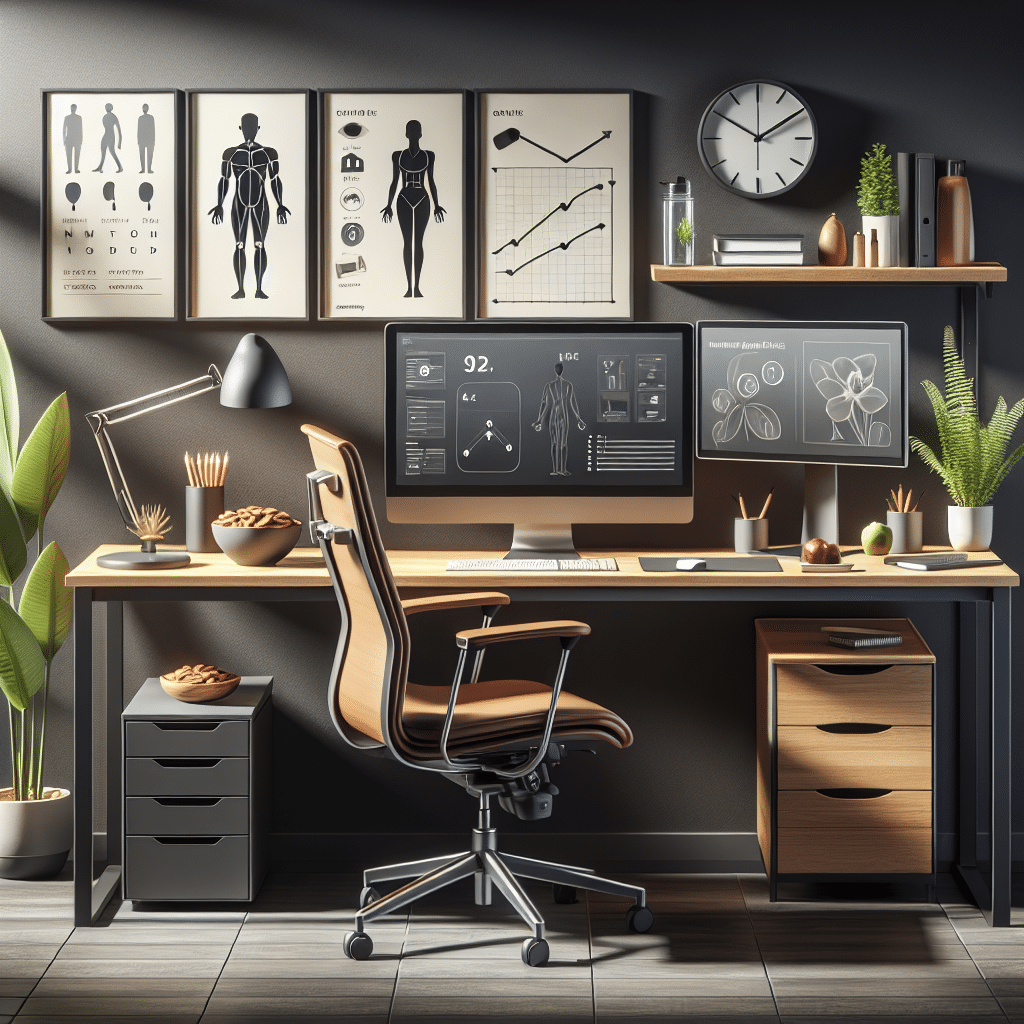Understanding the Importance of Ergonomics
Ergonomics is the science of designing the workspace to fit the user’s needs, promoting comfort and productivity. A healthy desk setup minimizes physical strain and reduces the risk of chronic conditions, such as back pain and repetitive strain injuries. When working long hours, creating an ergonomic workspace is essential for maintaining focus and enhancing work efficiency.
Desk Height
The height of your desk is fundamental for an ergonomic setup. A desk that is too high or too low can lead to poor posture. Ideally, when seated, your elbows should be at a 90-degree angle or slightly obtuse while your feet rest flat on the ground. If your desk is too high, consider using adjustable chairs or desk risers. Conversely, if your desk is too low, a stable platform could help elevate your setup.
Chair Selection
Investing in a quality office chair is vital. Look for a chair that supports the natural curvature of your spine. It should have adjustable seat height, lumbar support, and armrests. A chair with a waterfall seat design can help reduce pressure on your thighs, promoting better blood circulation. Prioritize materials that facilitate breathability, cushioning, and support.
Monitor Positioning
The position of your monitor significantly impacts your posture. Ideally, the top of the monitor screen should be at or slightly below eye level, about an arm’s length away. This distance helps prevent eye strain, with proper angles minimizing neck and shoulder discomfort. If you work with multiple screens, position them at the same height to avoid twisting your neck.
Keyboard and Mouse Placement
Your keyboard and mouse should be arranged such that your wrists remain in a neutral position. The keyboard should be placed at a height that allows your elbows to stay at a 90-degree angle, with your wrists straight. An ergonomic keyboard can provide additional comfort by separating the keys, allowing for a more natural hand position. Similarly, consider an ergonomic mouse or a mouse pad with wrist support to reduce strain.
Anti-Fatigue Mat
For those using a standing desk or frequently transitioning between sitting and standing, an anti-fatigue mat can help alleviate discomfort. These mats reduce fatigue on your legs, encouraging you to stand for extended periods. Look for mats with cushioning and sufficient width to allow movement while standing.
Lighting Conditions
Good lighting is crucial for reducing eye strain and maintaining productivity. Natural light is ideal, but if not available, ensure you use adjustable lamps that reduce glare. Position your light source to minimize reflections on your screens. Blue light filtering technology in your screens can also help protect your eyes, especially during late hours.
Declutter Your Space
A tidy workspace enhances focus and reduces stress. Regularly declutter your desk to maintain a conducive environment. Use organizers, trays, and cable management solutions to keep everything in its right place. A clean desk promotes mental clarity, enabling you to concentrate better on your tasks.
Personalization and Decor
While maintaining a professional look is crucial, personalizing your space can boost motivation and creativity. Incorporate elements that inspire you, like artwork, plants, or motivational quotes. However, ensure your decor does not create clutter. Plants not only beautify but also improve air quality, making them an excellent addition to your workspace.
Breaks and Movement
Even with the perfect desk setup, remaining stationary for hours can negatively impact your health. Implement the 20-20-20 rule: every 20 minutes, look at something 20 feet away for 20 seconds to reduce eye strain. Additionally, consider short breaks to stretch and move around every hour. Incorporating walking breaks can enhance circulation and invigorate your mind.
Hydration and Nutrition
Keep water at your desk to stay hydrated. Dehydration can lead to decreased concentration and fatigue, making it crucial to drink enough throughout the day. Healthy snacks can also improve energy levels. Opt for nuts, fruits, or yogurt instead of sugary treats to avoid energy crashes later.
Temperature Control
The temperature of your workspace can greatly affect comfort and productivity. Ideally, keep your workspace at a comfortable temperature, around 68-72°F (20-22°C). Adjustable fans or heaters can help you manage extreme conditions without distraction. A comfortable environment helps maintain focus and efficiency during long working hours.
Technology Tools
Utilize technology to enhance your productivity. Apps that remind you to take breaks, maintain good posture, or help with organization can be invaluable. Ergonomic software can alert you or even adjust your screen brightness. Explore tools that minimize repetitive tasks, allowing you to concentrate on more demanding responsibilities.
Cable Management
Managing cables can reduce clutter in your workspace, creating a seamless environment. Use cable trays, clips, or sleeves to keep cables organized. Not only does this aesthetic improvement create a calmer atmosphere, but it also prevents potential hazards caused by tangled wires.
Regular Office Ergonomics Assessment
Conduct a regular assessment of your desk setup. Your needs may change with time, or certain pieces of furniture may not serve you as well as when you first set them up. Remember, adjustments don’t always require new furniture. Minor alterations can significantly improve comfort and productivity.
Flexibility and Adaptability
Lastly, being flexible and adaptable is essential. As work demands change, so too should your desk setup. Experiment with various configurations and tools to find what suits you best. Approaching your workspace with a mindset of adaptation ensures longevity in your comfort and productivity.
Conclusion and Continuous Improvement
Personal investment in your workspace can lead to significant returns in productivity and well-being. Regularly reassess and improve your setup, staying informed about the latest ergonomic solutions and technologies. Following these detailed recommendations will help cultivate a healthy and supportive workspace tailored for long hours of productivity.
